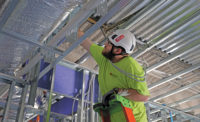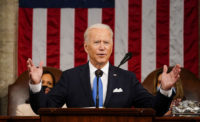Infrastructure contractor Lane Construction has shown a willingness to pursue business down roads less traveled. After decades as a major player in highway construction, Lane is moving into public-private partnerships and energy as part of the teams that built two major P3 highway projects, totaling $3 billion, in northern Virginia as well as two $800-million natural-gas powerplants now underway in Pennsylvania. Thanks partly to the completed Interstate 495 and Interstate 95 P3s, Lane’s regional revenue jumped 38%, to $593 million, last year. In light of its successes in new lines of business, ENR MidAtlantic has named Lane Construction its 2015 Contractor of the Year.
Although Lane is now reaping the rewards of its P3 work, the initiative required a commitment of more than a decade of company resources. Mike Cote, Lane’s chief development officer, says partnering was the key in the company’s decision to pursue P3 work.
Although he says the company has been historically conservative in its pursuits, its executives saw a sound opportunity with Fluor Corp., which first approached Lane in the late 1990s about P3 opportunities in Virginia. “Fluor is legendary in the infrastructure market,” Cote says. “They know the market. We have good complementary skills and strengths that work well with them. They are very strong on the process and administration side. We are good at fieldwork and managing labor. It’s a good fit.”
Herb Morgan, senior vice president of Fluor’s Infrastructure business, says, “When we started looking at work in Virginia, we needed someone we could team with that had a philosophy that lined up well with ours.” Morgan adds, “Lane has turned out to be one of our best partners at all levels. We work pretty seamlessly together. It’s an open partnership—meaning, we’re not hiding anything from each other.”
Lane was not an equity partner in the Virginia projects but served as, essentially, the builder. Cote says that was a conservative approach that allowed the company to gain valuable experience with the P3 process. “We learned how to deal with big partners that could take us places we couldn’t get to ourselves,” he adds.
Through those efforts, Lane proved its ability to deliver on megaprojects. The 495 Express Lanes project, which broke ground in 2008 and opened in 2012, added four high-occupancy toll, or HOT, lanes along a 14-mile segment of the Capital Beltway. The 95 Express Lanes project, which opened last December, delivered 29 miles of HOT lanes south of the Beltway. The 29-month project was delivered two weeks early.
The projects also spotlighted Lane’s commitment to safety. Although the projects were built along some of the most congested highways on the East Coast, the Fluor-Lane team achieved more than five million work-hours without an accident on the 495 Express Lanes job and four million safe work-hours on the 95 Express Lanes project.
Lane’s regional network of asphalt plants helped it to win work and gain an edge on its competition. For example, the company has two plants near the 495 Express and 95 Express sites. Cote says the asphalt business accounts for roughly 40% of the company’s revenue.
Through its recent experience, Lane is positioned to land more business in the MidAtlantic region and beyond, says Joe Lark, senior vice president. “We’ve gained the comfort and confidence to participate in P3 pursuits,” he says. The company continues to look into possible ventures with Fluor and other partners, including teaming with Skanska on the I-4 Ultimate project in Florida.









Post a comment to this article
Report Abusive Comment